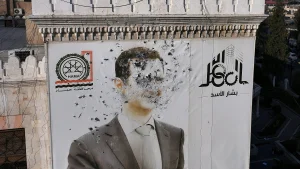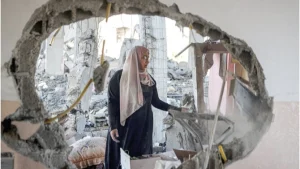While Bombs Fall, China Powers Hope with Solar in Gaza
In Gaza’s refugee camps, besieged by Israeli forces, the most crucial survival tool may come as a surprise: solar panels.
Hanin A. Elholy, a writer from Gaza, lost his house in Israeli military operations on May 12th and has since been living in a tent in a refugee camp.
“The way we measure our living standards has shifted,” he says. “Now, it’s about who has the bigger tent and who has solar panels.”
 A Small solar panel installed in a Gaza refugee camp.
A Small solar panel installed in a Gaza refugee camp.
While food and water are essential to life, in Gaza, a city under siege, electricity means something more for local people. This because fresh food and clean water require electricity to access. The ability to charge a phone can also mean life or death, as residents must stay informed to avoid military strikes.
These solar panels, largely from China, have become a literal lifeline for Gazans amid the chaos of war.
A City Powered by Solar
Solar power has played a crucial role in Gaza long before the current conflict.
According to a 2022 analysis by the Center for Strategic and International Studies (CSIS), satellite images showed at least 655 rooftop solar systems in a one-square-mile sample area of Gaza City, potentially one of the highest densities of home solar installations in the world. By 2023, the region was estimated to have over 12,000 rooftop solar systems.
Local solar engineers estimate that one-third of Gaza’s population and over half of its businesses use solar panels, which may provide up to 25% of Gaza’s total electricity.
 Solar panels placed atop a bakery building used to power it, in Gaza City
Solar panels placed atop a bakery building used to power it, in Gaza City
However, installing home panels can be a costly investment, even for family in many developing countries.
In Gaza, the widespread adoption of solar power stems from a harsh reality.
Gaza’s 2 million Palestinian require around 500 megawatts of electricity, but in normal times, they receive just 180 megawatts. As a result, Gaza is forced to divide its power supply by region, with different areas receiving electricity in an 8-hour shift.
Given the situation, Israel controls Gaza’s entire power supply, with 120 megawatts generated by Israeli power plants and 60 megawatts coming from a local plant that also relies on fuel supplied by Israel.
Consequently, power outages become a common tactic used by Israel to punish Palestinian during periods of conflicts.
For instance, in August 2020, amid a heatwave, Israel cut off fuel supplies to Gaza’s power plant, reducing electricity access to just four hours a day.
In such circumstances, solar power becomes the only reliable source of energy.
Despite the cost, Gazans are willing to invest heavily in solar panels.
Installing a solar power system in Gaza costs between $1,000 and $10,000, while the average daily income is just $13.
But for many, the long-term benefits make the investment worthwhile.
 A solar farm facility next to an agricultural field in Gaza City.
A solar farm facility next to an agricultural field in Gaza City.
Take Ahmed Abu Safia, for example. He owns a poultry farm in Gaza, and frequent power outages have caused many of his chickens to die from extreme temperatures, while egg production has declined due to insufficient lighting.
After taking out a $6,000 loan to install solar panels, he was able to increase his farm’s capacity from 1,000 to 3,000 chickens—a worthwhile investment, if not for the constant disruptions caused by war.
A Light of Survival
The war has disrupted more than just business, while it has brought a pressing survival crisis. For refugees like Elholy, solar power has become even more critical.
His camp, located on a local farmer’s land, has access to water from wells powered by the farmer’s 15 solar panels.
In a place where water scarcity has become Gaza’s greatest humanitarian crisis, this solar-powered access to clean water is a lifeline.
Under normal circumstances, three Israeli pipelines supply about 10% of Gaza’s freshwater. However, according to an August report by the United Nations, these pipelines are now operating at just 80% capacity.
Gaza’s local water plants have suffered even more severe damage, including the Canadian-funde water facility known as the Canada Well. It is located in Rafah, the southern city in Gaza, which was reportedly bombed by Israeli forces.
The U.N. report also found that Gaza’s current water supply is just a quarter of what it was before the conflict started in October 2023.
Oxfam researcher Bushra Khalidi also noted that Gaza residents are now getting less than five liters of water per person per day, which is roughly the amount needed for a single toilet flush.
Despite this limited amount, many refugees can only access water every two days, often waiting in line for up to several hours each time.
 Palestinians displaced by Israeli bombardment queue for water at a makeshift tent camp.
Palestinians displaced by Israeli bombardment queue for water at a makeshift tent camp.
In addition to water shortages, pollution has become a critical issue.
Streets are flooded with wastewater from broken sewage lines, leading to outbreaks of diseases, with polio, a disease nearly eradicated worldwide, reemerging in the region.
Additionally, an unprecedented skin disease is spreading among children. In severe cases, it manifests as burn-like symptoms, which local doctors say they have never seen before.
 Water pollution causes skin diseases among children in Gaza.
Water pollution causes skin diseases among children in Gaza.
In February, a report from the United Nations Relief and Works Agency (UNRWA) stated that around 70% of Gaza’s population is consuming water that is either salty or contaminated. Doctors Without Borders staff have noted that flu, dehydration, and hepatitis are among the major health consequences stemming from Gaza’s ongoing water crisis.
To address the shortage of fresh water, the U.N. and local NGOs have introduced solar-powered wells. Today, as the conflict continues, there is a growing reliance on these wells as a critical source of clean water.
Muhammad Al-Salhiya, a local resident, installed solar panels to power his private well, enabling him to provide water for 1,000 people daily.
“I fill my truck with 6,500 liters of water and distribute it to those in need,” he says. “It’s heartbreaking to see people carrying water in wheelchairs, but it’s making a difference.”
 Gaza residents line up to collect water at a solar-powered well.
Gaza residents line up to collect water at a solar-powered well.
A Foundational Human Right
As one of the most important forms of clean energy, solar power has long been promoted by developed countries. By 2012, Germany’s installed solar capacity had reached 32.64 million kilowatts, generating 4.5% of the country’s electricity.
In comparison, that same year, there were totally 12 solar panels in Gaza.
At the time, the high cost of solar power made it a luxury available only to developed nations.
However, Gaza serves as a reminder that those suffering in poverty and war are more desperate to embrace new technologies than residents of developed countries.
With its dry climate and 320 days of sunlight a year, the Middle East is well-suited for solar development. What was needed was a drop in costs to make it accessible.
Over the past decade, the global cost of solar power has dropped by 90%, with China emerging as the driving force behind this price reduction.
The decrease in solar costs can be attributed to two factors: technological breakthroughs and economies of scale.
The most significant price drops occurred between 2010 and 2012, as well as in 2016, coinciding with the rapid expansion of China’s production capacity. Today, China dominated over 80% of the global solar supply chain, with certain sectors exceeding 97%.
 Historical Price Trends of Solar Panels by Orient Securities
Historical Price Trends of Solar Panels by Orient Securities
While Western countries have imposed strict export restrictions on Chinese solar products, citing anti-dumping and countervailing duties, for much of the developing world, the low costs not only offer economic benefits but also save lives.
China’s cost-effective solar products have been widely used in electricity projects supported by the Palestinian government and international humanitarian organizations.
For example, in 2018, ET Solar, a Chinese company, won a bid for the Palestinian Investment Fund’s solar project in the West Bank, with an installed capacity of 16.5 megawatts.
In Gaza, it’s often not the bombs that kill children, but the lack of electricity in hospitals. In 2020, the Chinese government funded a 30-kilowatt solar project at Al-Durra Children’s Hospital in Gaza, which now supplies 60% of the hospital’s electricity needs.
 The China-funded solar system at Al-Durra Children’s Hospital
The China-funded solar system at Al-Durra Children’s Hospital
Additionally, since 2016, China has participated a project aimed at installing small solar systems for impoverished families in Gaza. By 2019, the project had completed at least four phases, benefiting hundreds of households.
Beyond humanitarian projects, Chinese solar companies also operate commercially in Palestine. Trina Solar’s website showcases a 100-kilowatt commercial rooftop project in the region.
The rapid development of solar power in Gaza has even opened window of opportunity for several promising startups.
Sun-Box, one of Gaza’s largest solar installation companies, began its operations in 2018. Kamal Almash-harawi, the company’s operations director, notes that their products primarily came from China.
In 2021, Sun-Box revealed that it had provided electricity to 65,000 people in Gaza and had partnered with the government to install solar panels at Gaza’s desalination plants.
It has also expanded its business into neighboring Middle Eastern countries, launching solar pilot projects at mosques in Saudi Arabia and exploring business opportunities in Lebanon and Jordan.
Since the two World Wars, Palestinians have had opportunities to establish an independent state. However, their weak economic foundation has hindered their ability to form a stable political organization, in stark contrast to the Jewish community after World War II.
Now, solar power not only provides a lifeline for Palestinians, but also offers a pathway toward energy and economic independence, with technology playing a key role in protecting their human rights.
Yet, the ongoing war continues to strangle Gaza.
Whenever conflicts break up, rooftop solar panels are prone to be destroyed by airstrikes, wiping out Gaza’s significant financial investments.
 A damaged solar panel.
A damaged solar panel.
In December of last year, Sun-Box’s office and warehouse were bombed, forcing Kamal and his family to flee to Riyadh.
“The company is closed, and I don’t even know if my employees are still alive or injured. I can’t contact them due to internet outages,” he said.
“I used to hear inspiring stories about startups before the war, but I believe those stories no longer exist. The infrastructure, customer base, and investments—everything has been destroyed.”
While technology offers hope to the people of Gaza and falling costs provide opportunities to secure human rights, peace remains the essential foundation for everything. Beyond solar power, the people of Gaza need more substantial international support.




